Flight into Egypt
from wikipedia.org
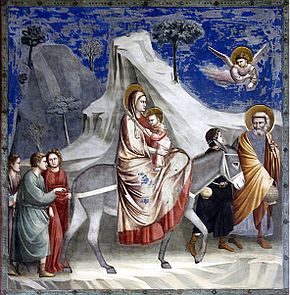 The flight into Egypt is a story recounted in the Gospel of Matthew (Matthew 2:13–23) and in New Testament apocrypha. Soon after the visit by the Magi, an angel appeared to Joseph in a dream telling him to flee to Egypt with Mary and the infant Jesus since King Herod would seek the child to kill him. The episode is frequently shown in art, as the final episode of the Nativity of Jesus in art, and was a common component in cycles of the Life of the Virgin as well as the Life of Christ. Within the narrative tradition, iconic representation of the "Rest on the Flight into Egypt" developed after the 14th century.
Matthew's gospel account
The flight into Egypt is a story recounted in the Gospel of Matthew (Matthew 2:13–23) and in New Testament apocrypha. Soon after the visit by the Magi, an angel appeared to Joseph in a dream telling him to flee to Egypt with Mary and the infant Jesus since King Herod would seek the child to kill him. The episode is frequently shown in art, as the final episode of the Nativity of Jesus in art, and was a common component in cycles of the Life of the Virgin as well as the Life of Christ. Within the narrative tradition, iconic representation of the "Rest on the Flight into Egypt" developed after the 14th century.
Matthew's gospel account
The flight from Herod
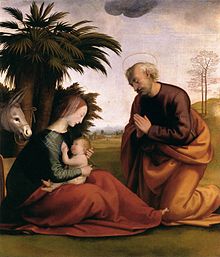 When the Magi came in search of Jesus, they went to Herod the Great in Jerusalem to ask where to find the newborn "King of the Jews". Herod became paranoid that the child would threaten his throne, and sought to kill him (2:1–8). Herod initiated the Massacre of the Innocents in hopes of killing the child (Matthew 2:16–Matthew 2:18). But an angel appeared to Joseph in a dream and warned him to take Jesus and his mother into Egypt (Matthew 2:13).
When the Magi came in search of Jesus, they went to Herod the Great in Jerusalem to ask where to find the newborn "King of the Jews". Herod became paranoid that the child would threaten his throne, and sought to kill him (2:1–8). Herod initiated the Massacre of the Innocents in hopes of killing the child (Matthew 2:16–Matthew 2:18). But an angel appeared to Joseph in a dream and warned him to take Jesus and his mother into Egypt (Matthew 2:13).
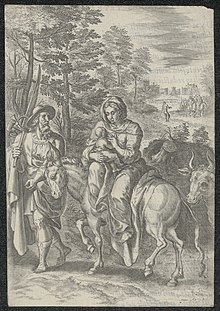 Egypt was a logical place to find refuge, as it was outside the dominions of King Herod, but both Egypt and Judea were part of the Roman Empire, linked by a coastal road known as "the way of the sea", making travel between them easy and relatively safe.
Return from Egypt
Egypt was a logical place to find refuge, as it was outside the dominions of King Herod, but both Egypt and Judea were part of the Roman Empire, linked by a coastal road known as "the way of the sea", making travel between them easy and relatively safe.
Return from Egypt
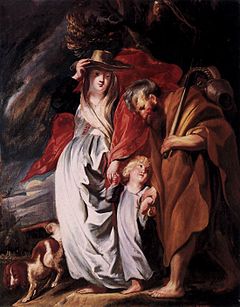 After a time, the holy family returned from Egypt. The text states that Herod had died. Herod is believed to have died in 4 BC, and while Matthew does not mention how, the Jewish historian Josephus vividly relates a gory death.
The land that the holy family return to is identified as Judah, the only place in the entire New Testament where Judah acts as a geographic description of the whole of Judah and Galilee (Matthew 2:20), rather than referring to a collection of religious people or the Jewish people in general. It is, however, to Judah that they are described as initially returning, although upon discovering that Archelaus had become the new king, they went instead to Galilee. Historically, Archelaus was such a violent and aggressive king that in the year 6 AD he was deposed by the Romans, in response to complaints from the population. Galilee was ruled by a much calmer king, Herod Antipas, and there is historical evidence that Galilee had become a refuge for those fleeing the iron rule of Archelaus.
Prophecy of Hosea
Matthew 2:15 cites Hosea 11:1 as prophetically fulfilled in the return of Joseph, Mary and Jesus from Egypt: "... and out of Egypt I called My son".
Matthew's use of Hosea 11:1 has been explained in several ways. A sensus plenior approach states that the text in Hosea contains a meaning intended by God and acknowledged by Matthew, but unknown to Hosea. A typological reading interprets the fulfillment as found in the national history of Israel and the antitypical fulfillment as found in the personal history of Jesus. Matthew's use of typological interpretation may also be seen in his use of Isaiah 7:14 and 9:1, and Jeremiah 31:15.
After a time, the holy family returned from Egypt. The text states that Herod had died. Herod is believed to have died in 4 BC, and while Matthew does not mention how, the Jewish historian Josephus vividly relates a gory death.
The land that the holy family return to is identified as Judah, the only place in the entire New Testament where Judah acts as a geographic description of the whole of Judah and Galilee (Matthew 2:20), rather than referring to a collection of religious people or the Jewish people in general. It is, however, to Judah that they are described as initially returning, although upon discovering that Archelaus had become the new king, they went instead to Galilee. Historically, Archelaus was such a violent and aggressive king that in the year 6 AD he was deposed by the Romans, in response to complaints from the population. Galilee was ruled by a much calmer king, Herod Antipas, and there is historical evidence that Galilee had become a refuge for those fleeing the iron rule of Archelaus.
Prophecy of Hosea
Matthew 2:15 cites Hosea 11:1 as prophetically fulfilled in the return of Joseph, Mary and Jesus from Egypt: "... and out of Egypt I called My son".
Matthew's use of Hosea 11:1 has been explained in several ways. A sensus plenior approach states that the text in Hosea contains a meaning intended by God and acknowledged by Matthew, but unknown to Hosea. A typological reading interprets the fulfillment as found in the national history of Israel and the antitypical fulfillment as found in the personal history of Jesus. Matthew's use of typological interpretation may also be seen in his use of Isaiah 7:14 and 9:1, and Jeremiah 31:15.
 Another reading of Hosea's prophetic declaration is that it only recounts God summoning of the nation of Israel out of Egypt during the Exodus, referring to Israel as God's son in accordance with Moses' declaration to Pharaoh: "Israel is my first-born son; let my son go, that he may serve me" (Exodus 4:22–23).
The Massoretic Text reads my son, whereas the Septuagint reads his sons or his children; the Massoretic Text is to be preferred, the singular being both consonant with the other words which are in the singular in Hosea 11:1 and with the reference to Exodus 4:22–23. The Septuagint reading may be explained as having been made to conform to the plurals of Hosea 11:2, they and them.
Historicity
Another reading of Hosea's prophetic declaration is that it only recounts God summoning of the nation of Israel out of Egypt during the Exodus, referring to Israel as God's son in accordance with Moses' declaration to Pharaoh: "Israel is my first-born son; let my son go, that he may serve me" (Exodus 4:22–23).
The Massoretic Text reads my son, whereas the Septuagint reads his sons or his children; the Massoretic Text is to be preferred, the singular being both consonant with the other words which are in the singular in Hosea 11:1 and with the reference to Exodus 4:22–23. The Septuagint reading may be explained as having been made to conform to the plurals of Hosea 11:2, they and them.
Historicity
The Gospel of Luke does not recount this story, relating instead that the Holy Family went to the Temple in Jerusalem, and then home to Nazareth. Followers of the Jesus Seminar thus conclude that both Luke's and Matthew's birth and infancy accounts are fabrications. A theme of Matthew is likening Jesus to Moses for a Judean audience, and the Flight into Egypt illustrates just that theme. Extra-biblical accounts
Christian
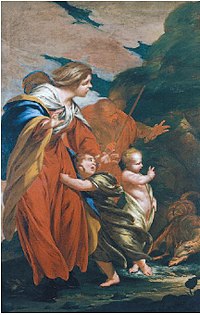 The story was much elaborated in the "Infancy Gospels" of the New Testament apocrypha with, for example, palm trees bowing before the infant Jesus, Jesus taming dragons, the beasts of the desert paying him homage, and an encounter with the two thieves who would later be crucified alongside Jesus. In these later tales the family was joined by Salome as Jesus' nurse. These stories of the time in Egypt have been especially important to the Coptic Church, which is based in Egypt, and throughout Egypt there are a number of churches and shrines marking places where the family stayed. The most important of these is the church of Abu Serghis, which claims to be built on the place the family had its home.
One of the most extensive and, in Eastern Christianity, influential accounts of the Flight appears in the perhaps seventh-century Gospel of Pseudo-Matthew, in which Mary, tired by the heat of the sun, rested beneath a palm tree. The infant Jesus then miraculously has the palm tree bend down to provide Mary with its fruit, and release from its roots a spring to provide her with water.
Muslim
The Qur'an does not include the tradition of the Flight into Egypt, though sura XXIII, 50 could conceivably allude to it: “And we made the son of Maryam and his mother a sign; and we made them abide in an elevated place, full of quiet and watered with springs”. However, its account of the birth of Jesus is very similar to the account of the Flight in the Gospel of Pseudo-Matthew: Mary gives birth leaning against the trunk of a date-palm, which miraculously provides her with dates and a stream. It is therefore thought that one tradition owes something to the other.
Numerous later Muslim writers on the life of Jesus did transmit stories about the Flight into Egypt. Prominent examples include Abu Is?a? al-Tha?labi, whose ?Ara?is al-madjalis fi ?i?a? al-anbiya?, an account of the lives of the prophets, reports the Flight, followed by a stay in Egypt of twelve years; and al-?abari's History of the Prophets and Kings.
In art
The story was much elaborated in the "Infancy Gospels" of the New Testament apocrypha with, for example, palm trees bowing before the infant Jesus, Jesus taming dragons, the beasts of the desert paying him homage, and an encounter with the two thieves who would later be crucified alongside Jesus. In these later tales the family was joined by Salome as Jesus' nurse. These stories of the time in Egypt have been especially important to the Coptic Church, which is based in Egypt, and throughout Egypt there are a number of churches and shrines marking places where the family stayed. The most important of these is the church of Abu Serghis, which claims to be built on the place the family had its home.
One of the most extensive and, in Eastern Christianity, influential accounts of the Flight appears in the perhaps seventh-century Gospel of Pseudo-Matthew, in which Mary, tired by the heat of the sun, rested beneath a palm tree. The infant Jesus then miraculously has the palm tree bend down to provide Mary with its fruit, and release from its roots a spring to provide her with water.
Muslim
The Qur'an does not include the tradition of the Flight into Egypt, though sura XXIII, 50 could conceivably allude to it: “And we made the son of Maryam and his mother a sign; and we made them abide in an elevated place, full of quiet and watered with springs”. However, its account of the birth of Jesus is very similar to the account of the Flight in the Gospel of Pseudo-Matthew: Mary gives birth leaning against the trunk of a date-palm, which miraculously provides her with dates and a stream. It is therefore thought that one tradition owes something to the other.
Numerous later Muslim writers on the life of Jesus did transmit stories about the Flight into Egypt. Prominent examples include Abu Is?a? al-Tha?labi, whose ?Ara?is al-madjalis fi ?i?a? al-anbiya?, an account of the lives of the prophets, reports the Flight, followed by a stay in Egypt of twelve years; and al-?abari's History of the Prophets and Kings.
In art
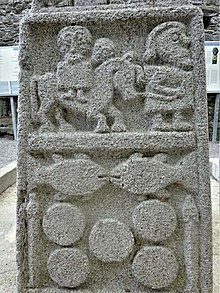 The Flight into Egypt was a popular subject in art, showing Mary with the baby on a donkey, led by Joseph, borrowing the older iconography of the rare Byzantine Journey to Bethlehem. Nevertheless, Joseph is sometimes holding the child on his shoulders. Before about 1525, it usually formed part of a larger cycle, whether of the Nativity, or the Life of Christ or Life of the Virgin.
The Flight into Egypt was a popular subject in art, showing Mary with the baby on a donkey, led by Joseph, borrowing the older iconography of the rare Byzantine Journey to Bethlehem. Nevertheless, Joseph is sometimes holding the child on his shoulders. Before about 1525, it usually formed part of a larger cycle, whether of the Nativity, or the Life of Christ or Life of the Virgin.
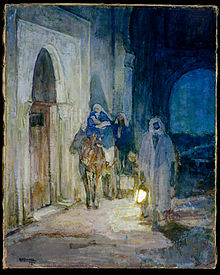 A subject taking place after the arrival in Egypt is the meeting of the infant Jesus with his cousin, the infant John the Baptist, who, according to legend was rescued from Bethlehem before the massacre by the Archangel Uriel, and joined the Holy Family in Egypt. This meeting of the two Holy Children was to be painted by many artists during the Renaissance period, after being popularized by Leonardo da Vinci and then Raphael with works like Leonardo's Virgin of the Rocks.
The "Flight into Egypt" was a favorite theme of Henry Ossawa Tanner, depicting the Holy Family's clandestine evasion of King Herod's assassins (Matthew 2:12–14). In it Tanner expresses his sensitivity to issues of personal freedom, escape from persecution, and migrations of African-Americans from the South to the North.
Two plays of the medieval Ordo Rachelis cycle contain an account of the flight into Egypt, and the one found in the Fleury Playbook contains the only dramatic representation of the return from Egypt.
The oratorio L'enfance du Christ (1854) by French composer Hector Berlioz relates the events from Herod's dream and his meeting with the Magi through the angels' warning and the flight into Egypt until the Holy Family arrive at Sais.
Nazarenes, Nazareth, and Nazirites
A subject taking place after the arrival in Egypt is the meeting of the infant Jesus with his cousin, the infant John the Baptist, who, according to legend was rescued from Bethlehem before the massacre by the Archangel Uriel, and joined the Holy Family in Egypt. This meeting of the two Holy Children was to be painted by many artists during the Renaissance period, after being popularized by Leonardo da Vinci and then Raphael with works like Leonardo's Virgin of the Rocks.
The "Flight into Egypt" was a favorite theme of Henry Ossawa Tanner, depicting the Holy Family's clandestine evasion of King Herod's assassins (Matthew 2:12–14). In it Tanner expresses his sensitivity to issues of personal freedom, escape from persecution, and migrations of African-Americans from the South to the North.
Two plays of the medieval Ordo Rachelis cycle contain an account of the flight into Egypt, and the one found in the Fleury Playbook contains the only dramatic representation of the return from Egypt.
The oratorio L'enfance du Christ (1854) by French composer Hector Berlioz relates the events from Herod's dream and his meeting with the Magi through the angels' warning and the flight into Egypt until the Holy Family arrive at Sais.
Nazarenes, Nazareth, and Nazirites
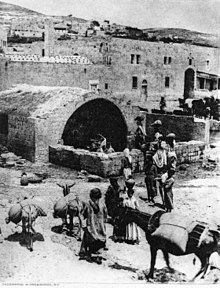 While Luke places Jesus' family as being originally from the town of Nazareth, Matthew has the family moving there, fearing Archelaus who was ruling in Judea in place of his father Herod. Nazareth, now a town, is not mentioned by the Old Testament, Josephus or rabbinical sources, though many Christian Bible archaeologists, such as the evangelical and egyptologist Kenneth Kitchen, state that they are fairly sure that a village existed in the area at the time of Jesus. Clarke notes that the location of Nazareth is just to the north of where the large town Sepphoris was located. At the time, Sepphoris had been largely destroyed in the violence following the death of Herod the Great, and was being rebuilt by Herod Antipas, hence Clarke speculates that this could have been seen as a good source of employment by Joseph, a carpenter.
The difficulty with the brief quote "he will be called a Nazarene" is that it occurs nowhere in the Old Testament, or any other extant source. The most similar known passage is Judges 13:5 where of Samson it says "the child shall be a Nazirite", where a nazirite was a specific type of religious ascetic. That the Nazirite and Nazareth are so similar in name, while Nazareth isn't mentioned in any other source until after the Gospels have been written, and that the passage almost parallels one about the birth of a hero who was a Nazirite, has led many to propose that Matthew originally had Jesus being a Nazirite, but it was changed to Nazarene, inventing a location named Nazareth, when the ascetic requirements fell foul of later religious practices. Biblical scholar R. T. France rejects this explanation, stating that Jesus was not a Nazirite and claiming that he is never described as one.
Another theory is that it is based on a prophecy at Isaiah 11:1, which states "there shall come forth a rod out of the stem of Jesse, and a Branch shall grow out of his roots": — the Hebrew for branch is netzer. The priestly clan of the "netzerites" possibly settled in the place which became known as Netzereth/ Nazareth. Bargil Pixner[21] in his work "With Jesus Through Galilee" says that the title Nazarene, given to Jesus, alludes not so much to his town of origin as to his royal descent. While this piece of wordplay is meaningless when translated into Greek, Hebrew wordplay is not unknown in Matthew, underlining the opinion that some parts of this gospel were originally written in Hebrew.
While Luke places Jesus' family as being originally from the town of Nazareth, Matthew has the family moving there, fearing Archelaus who was ruling in Judea in place of his father Herod. Nazareth, now a town, is not mentioned by the Old Testament, Josephus or rabbinical sources, though many Christian Bible archaeologists, such as the evangelical and egyptologist Kenneth Kitchen, state that they are fairly sure that a village existed in the area at the time of Jesus. Clarke notes that the location of Nazareth is just to the north of where the large town Sepphoris was located. At the time, Sepphoris had been largely destroyed in the violence following the death of Herod the Great, and was being rebuilt by Herod Antipas, hence Clarke speculates that this could have been seen as a good source of employment by Joseph, a carpenter.
The difficulty with the brief quote "he will be called a Nazarene" is that it occurs nowhere in the Old Testament, or any other extant source. The most similar known passage is Judges 13:5 where of Samson it says "the child shall be a Nazirite", where a nazirite was a specific type of religious ascetic. That the Nazirite and Nazareth are so similar in name, while Nazareth isn't mentioned in any other source until after the Gospels have been written, and that the passage almost parallels one about the birth of a hero who was a Nazirite, has led many to propose that Matthew originally had Jesus being a Nazirite, but it was changed to Nazarene, inventing a location named Nazareth, when the ascetic requirements fell foul of later religious practices. Biblical scholar R. T. France rejects this explanation, stating that Jesus was not a Nazirite and claiming that he is never described as one.
Another theory is that it is based on a prophecy at Isaiah 11:1, which states "there shall come forth a rod out of the stem of Jesse, and a Branch shall grow out of his roots": — the Hebrew for branch is netzer. The priestly clan of the "netzerites" possibly settled in the place which became known as Netzereth/ Nazareth. Bargil Pixner[21] in his work "With Jesus Through Galilee" says that the title Nazarene, given to Jesus, alludes not so much to his town of origin as to his royal descent. While this piece of wordplay is meaningless when translated into Greek, Hebrew wordplay is not unknown in Matthew, underlining the opinion that some parts of this gospel were originally written in Hebrew.
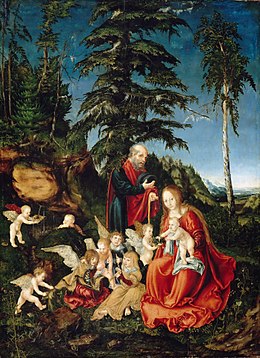 Christian traditions associated with the Flight into Egypt
Christian traditions associated with the Flight into Egypt
The Flight into Egypt is one of the listed Seven Sorrows of Mary. A local French tradition states that Saint Aphrodisius, an Egyptian saint who was venerated as the first bishop of Béziers, was the man who sheltered the Holy Family when they fled into Egypt. In Coptic Christianity, it is also held that the Holy family visited many areas in Egypt, including Musturud (where there is now the Church of the Virgin Mary), Wadi El Natrun (which has four large monasteries), and Old Cairo, along with Farama, Tel Basta, Samanoud, Bilbais, Samalout, Maadi, Al-Ma?ariyyah and Asiut among others. It is likewise tradition that the Holy Family visited Coptic Cairo and stayed at the site of Saints Sergius and Bacchus Church (Abu Serga) and the place where the Church of the Holy Virgin (Babylon El-Darag) stands now. At Al-Ma?ariyyah, then in Heliopolis and now part of Cairo, there is a sycamore tree (and adjacent chapel) that is a 1672 planting replacing an earlier tree under which Mary was said to have rested, or in some versions hidden from pursuers in the hollow trunk, while pious spiders covered the entrance with dense webs.